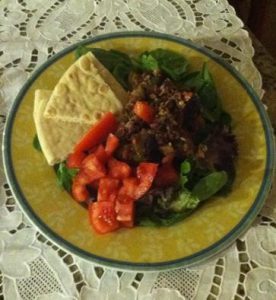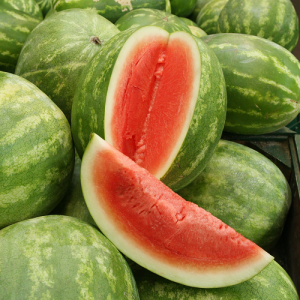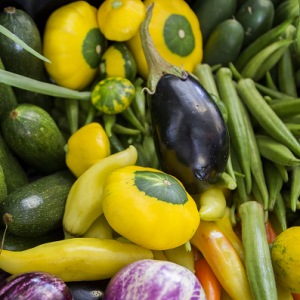
by Dorothy C. Lee | Apr 24, 2018
Grill Out Safely This Summer
Perhaps it’s the gentle climate with temperatures conducive to outdoor cooking for much of the year. Or it might be that an outdoor get-together with family, friends, and good food is a great way to celebrate the summer. Whatever the reasons, outdoor cookery is firmly established as a tradition in the South.
Outdoor cookery has given rise to many unique and flavor-filled recipes for foods that can be prepared on even the simplest grill. If long days of summer have you longing to fire up the grill, the following tips, delicious recipes, and helpful grilling charts will help make your outdoor cooking experience easy, safe, and rewarding.

Grilling
Photo Credit: Dorothy Lee
Safety is an important consideration when operating a grill. Improper use can cause a fire or explosion. Keep the area around a lighted grill clear of combustible materials, and never use a grill in an enclosed area such as a sheltered patio or a garage. Avoid wearing loose-fitting clothing that may catch fire. The cooking grids should be cleaned after every cookout. The last thing you want to do is cause someone to become ill due to improper cleaning or unsafe food preparation practices.
Wash your hands with hot soapy water for at least 20 seconds before starting to prepare any foods and wash your hands again if you do anything else—change a diaper, pet an animal, or blow your nose, for example. Cover any cuts or sores on your hands with a bandage or use plastic gloves. If you sneeze or cough while preparing foods, cover your mouth and nose with a tissue and turn your face away, or cough into your sleeve. Always wash your hands afterwards.
Bacteria multiply rapidly at room temperature. Most food-borne illness-causing bacteria cannot grow well at temperatures below 40°F or above 140°F. Thaw foods in the refrigerator or in the microwave. Never leave foods out at room temperature.
Keep everything that touches food clean. Bacteria can hitch rides around your kitchen on all sorts of things—plates and cutting boards, dirty utensils, dish rags and sponges, unwashed hands.
Never chop fresh vegetables or salad ingredients on a cutting board that was used for raw meat without properly cleaning it first. If possible, keep a separate cutting board just for the preparation of raw meat, poultry, and fish.
Wash cutting boards thoroughly with hot soapy water, and then sanitize with a solution of household bleach and water.
The most popular meat for outdoor grilling is beef, particularly ground beef. If ground beef burgers are to be the feature of your next cookout select freshly ground meat that has fat content of about 15%. Form the meat into loose patties. Cook hamburger patties to an internal temperature of 160°F.
Keep raw meat, poultry, fish, and their juices from coming into contact with other foods during preparation, especially foods that will not be cooked. Wash all utensils and your hands with hot soapy water after contact with raw meat.
Marinate meat, poultry and seafood in the refrigerator in a covered, non-metal container. Throw away any leftover marinade.
Grill food to a safe internal temperature. Use a meat thermometer to assure correct doneness of the food being grilled.
Safe minimum internal temperatures:
- Poultry (whole, ground, and breasts): 165°F
- Hamburgers, beef: 160°F
- Beef, veal, and lamb (steaks, roasts & chops):
- Medium rare: 145°F
- Medium: 160°F.
Hold meat at 140°F until served. Use a clean platter for transferring cooked meat from grill to serving table.
Summer is the time for getting together with friends and family and cooking outdoors. Make your outdoor grilling experience safe and enjoyable.
Safe Food Handling Fact Sheet, USDA, Food Safety and Inspection Series, https://www.foodsafety.gov/
When we think of foods to prepare outdoors we almost immediately think meat. However, grilled vegetables and grilled fruits make a delicious accompaniment to grilled meats.
Corn on the Cob Kabob
- 2 medium red onions, cut into 8 wedges each
- 4 fresh ears sweet corn, husked, silks removed, and cut crosswise into 4 pieces each
- Nonstick cooking spray
- ¼ cup butter, melted
- ¼ teaspoon garlic powder
- ¼ teaspoon onion powder
- ¼ teaspoon dried oregano, crushed
On each of eight 12-inch wooden skewers, alternately thread 2 onion wedges and 2 pieces of corn, leaving about ¼ inch between each vegetable. Lightly coat vegetables with nonstick spray.
For a charcoal grill, grill kabobs on the rack of an uncovered grill directly over medium coals for 15 to 18 minutes or until vegetables are tender and brown, turning occasionally to brown evenly. (For a gas grill, preheat grill. Reduce heat to medium. Place kabobs on grill rack over heat. Cover, grill as above.)
In a small bowl, combine butter, garlic powder, onion powder and oregano. Brush over vegetables. Makes 4 servings.
Cinnamon-Grilled Peaches
- 4 large ripe freestone peaches
- Eight 3-inch cinnamon sticks
- 8 fresh mint leaves
- 4 tablespoons unsalted butter
- ¼ cup firmly packed brown sugar
- ¼ cup dark rum
- ½ teaspoon ground cinnamon
- Pinch salt
- Peach or vanilla ice cream, for serving
Rinse the peaches and blot them dry with paper towels. Cut each peach in half and discard the pit. Then, cut each peach into quarters. Using a pointed chopstick or metal skewer, make a starter hole in the center of each peach quarter, working from the pit side to the skin side. Skewer 2 peach quarters on each cinnamon stick, placing a mint left between the 2 quarters.
Combine the butter, brown sugar, rum, cinnamon, and salt in a saucepan and bring to a boil over high heat. Let the glaze boil until thick and syrupy, about 5 minutes.
Prepare and preheat the grill to high. Brush and oil the grate. Next, place the skewered peaches on the hot grate and grill until nicely browned, 3 to 4 minutes per side, basting with the rum and butter glaze. Spoon any remaining glaze over the grilled peaches and serve at once. Peach or vanilla ice cream make a great accompaniment.

by Melanie Taylor | Feb 26, 2018
 Based on information provided by the American Frozen Food Institute, on average, 40% of all food in the United States goes uneaten and wasted, which is an annual loss of $165 million. Fresh fruit and vegetable waste makes up nearly one-third of this number. With these discouraging numbers and financial losses, how can the frozen food industry help to solve this problem? Frozen food and beverage companies work hard to create the safest and best freezing techniques to keep food safe by preventing microorganisms from growing and by slowing down the enzyme activity that causes food to spoil. Modern freezing techniques have been designed to preserve food at its peak freshness and nutrient content. Frozen food makers continue to work with the U.S. Department of Agriculture (USDA) and the U.S. Food and Drug Administration (FDA) to keep America’s food supply the safest in the world.
Based on information provided by the American Frozen Food Institute, on average, 40% of all food in the United States goes uneaten and wasted, which is an annual loss of $165 million. Fresh fruit and vegetable waste makes up nearly one-third of this number. With these discouraging numbers and financial losses, how can the frozen food industry help to solve this problem? Frozen food and beverage companies work hard to create the safest and best freezing techniques to keep food safe by preventing microorganisms from growing and by slowing down the enzyme activity that causes food to spoil. Modern freezing techniques have been designed to preserve food at its peak freshness and nutrient content. Frozen food makers continue to work with the U.S. Department of Agriculture (USDA) and the U.S. Food and Drug Administration (FDA) to keep America’s food supply the safest in the world.
Freezing means less wasted food and easier access to well-balanced, portion-controlled nutritious foods during every season and in every community. Many times, frozen foods cost less per serving, but most importantly, they have a longer shelf life than fresh or refrigerated foods.
How do frozen foods play such an integral part in the well-balanced, nutritious diets of Americans? The frozen food aisle offers a large variety of vegetables, fruits, and other prepared foods at reasonable prices year ’round. Freezing reduces the need for additives and preservatives. Frozen foods also provide nutritious options that fit into all of the food groups suggested by Choose MyPlate.gov (fruits, vegetables, whole grains, protein, and dairy). They also are a sensible choice when trying to control calories and fat, sugar, saturated fat, and sodium intake. In addition, unused products can be placed back in the freezer for later use.
If you have concerns about frozen foods, it’s time to rethink them. Let’s BUST those crazy frozen food myths swirling around out there!!!
FROZEN FOOD MYTHS VS. FACTS
MYTH: FROZEN FRUITS AND VEGGIES AREN’T AS NUTRITIOUS AS FRESH
FACT: Recent studies found there is no difference in nutrition between frozen and fresh produce.
MYTH: FROZEN FOODS ARE READY TO EAT
FACT: Frozen foods are ready to cook, not ready to eat. As their name suggests, ready-to-cook foods must be cooked or baked according to package instructions.
MYTH: FROZEN MEALS DON’T USE REAL INGREDIENTS
FACT: The freezer aisles of your supermarket are filled with meals made with the highest quality ingredients and prepared the way you would prepare them (if you had the time).
MYTH: FROZEN MEALS AREN’T ENVIRONMENTALLY FRIENDLY
FACT: Actually, frozen foods minimize the amount of spoiled food we throw away because they are already portioned out, so we can take what we need and save the rest.
MYTH: FROZEN MEALS ARE MORE EXPENSIVE THAN RESTAURANT TAKE-OUT MEALS
FACT: Restaurant-inspired entrees like seafood scampi, sesame chicken, and Monterey chicken cost under $4 each. You do the math.
MYTH: FROZEN MEALS ARE NOT A GOOD CHOICE FOR HEALTH-CONSCIOUS CONSUMERS
FACT: “Better-for-you” options are available in the frozen food aisle to make it easier for consumers to control intake of calories, fat, saturated fat, and sodium.
For more information on the frozen food and beverage industry, please visit www.affi.org.
For more information on incorporating frozen foods into your healthy lifestyle, please visit: http://edis.ifas.ufl.edu/fs186.
by Heidi Copeland | Aug 7, 2017
 Can you believe it is that time of year already to sneak some zucchini on your neighbor’s porch! Honestly, it is a day to celebrate. And celebrate we should! It is the lucky neighbor who profits from the gardeners abundant harvest. Nonetheless, what can one do with all that zucchini?
Can you believe it is that time of year already to sneak some zucchini on your neighbor’s porch! Honestly, it is a day to celebrate. And celebrate we should! It is the lucky neighbor who profits from the gardeners abundant harvest. Nonetheless, what can one do with all that zucchini?
The late, Julia Child bestows the virtue of ratatouille in many of her books yet it seemed to take an animated rat in the award winning Pixar film to suggest ratatouille might be something to try. Really! Ratatouille, a traditional French Provençal stewed vegetable dish, originating in Nice is a mostly Mediterranean fare, however, we too have all the local produce to adapt this delicious dish.
How? What do you need? Ratatouille can be made just the way you like it but start with the basics: onions, eggplant, zucchini, garlic, tomatoes, red, green or yellow peppers, mushrooms, and fresh or dried herbs and a pinch of salt and pepper.
Ratatouille is typically served as a side dish, but may also be served as a vegetable soup, or a meal on its own accompanied by pasta, rice or bread. Ratatouille is good as a topping for your favorite grilled meat or fish, or as a filling in a simple omelet. Did I mention it can be added to quiche? Or stuffed into a pita pocket?
There is as much deliberation on how to make a traditional ratatouille as there is about how you eat it. Do you layer it and bake it? Is it sautéed? Is it simmered? Is it eaten as a side dish, a main dish or a sandwich filling? I’ve tried them all and even found success using a slow-cooker.
Try your hand at this simple yet elegantly adaptable vegetable dish.
The provided very basic recipe can be adapted to suit your personal/regional taste. Don’t like eggplant? Leave it out! Have a lot of okra or yellow squash? Add it! Like olives, nuts or raisins? Add them to your portion. Rather not use vegetable oil? Don’t! Want to cover it in your favorite spicy olive oil? Do you have some extra zucchini? I think you get the picture.
Ratatouille does not have to look like the vibrant Pixar version yet, it is still going to garner up gracious comments and acknowledgements from those you love and cook for. Whip up your version to savor today!
Ratatouille
Ingredients:
2 Tablespoons any kind of oil
4 medium onions, chopped – any color, any kind
2 medium eggplant, cut into 3/4-inch cubes
4 garlic cloves, minced
6 medium zucchini, cut into 1-inch cubes
2 large green, red or yellow bell pepper seeded and cut in 1” cubes
8 to 10 ripe tomatoes, peeled, seeded coarsely chopped (or use a can of fire roasted diced tomatoes)
3 fresh thyme sprigs (or to taste)
1 fresh rosemary sprig (or to taste)
1 dried or two fresh bay leaves
1/2 tsp. salt
1/2 tsp. freshly ground pepper
Directions:
In a BIG pot over medium heat, warm the oil. When it is hot, reduce the heat to medium, add the onions and sauté until translucent, about 2 minutes. Add the eggplant and garlic and sauté, stirring often, until the eggplant cubes are slightly softened, 3 to 4 minutes.
Add the zucchini and bell pepper and sauté, stirring and turning, until softened, 4 to 5 minutes more. Add the tomatoes, thyme, rosemary, bay leaf, salt and pepper, and stir and turn for 2 to 3 minutes more.
Cover, reduce the heat to low and cook, stirring occasionally, until the vegetables are soft and have somewhat blended together, about 60 minutes. (slow cooker at least 4 hours on high)
Remove from heat. Garnish with minced fresh basil. Transfer to a serving bowl and serve hot, at room temperature or cold. Serves at least 10.
by Samantha Kennedy | Aug 5, 2017
 Oh, watermelon. How do I love thee? Let me count the ways.
Oh, watermelon. How do I love thee? Let me count the ways.
Watermelon is the perfect warm weather treat and a summer holiday essential. It’s a sweet, light, and delicious snack and its versatility lends itself to a wide variety of beverages, salads, meals, and desserts.
Watermelon is more than just water and sugar. It’s jam-packed with a number of vitamins and minerals that can help you stay healthy, including vitamin A, vitamin B6, vitamin C, potassium, and lycopene.
Vitamin A is vital to eye health and helps boost your immune system by supporting the functions of the infection-fighting white blood cells.
Vitamin B6 has many functions in the body, including aiding in immunity by supporting the creation of antibodies, which are needed to fight off infection. It also helps maintain proper nerve function and aids in the creation of red blood cells, which carry oxygen to all parts of the body. Vitamin B6 is also used to break down proteins into smaller parts that can be used to build and maintain muscle mass.
Vitamin C also helps boost immunity and overall cell health by helping to break down free radicals in the body, which can deteriorate cells over time.
Potassium is a mineral that is necessary for keeping a healthy water balance in the body, helping to maintain proper water balance and reducing the incidence of painful muscle cramps.
Lycopene is one of a family of vitamin precursors known as carotenoids. This substance is what helps give those bright red and pink fruits and vegetables – such as watermelon – their lovely color. Lycopene and other carotenoids function as antioxidants, which help eliminate those previously mentioned harmful free radicals. And preliminary studies have shown that lycopene may help reduce triglycerides and LDL cholesterol, which may lead to a reduction in cardiovascular disease risk.
Nearly every part of the watermelon can be eaten, from the sweet and juicy fruit to the rind, which is often pickled or used in stir frys. Even the fruit itself can be grilled and served as part of a savory dish. And watermelon is a sweet addition to many colorful summer salads.
One of my favorite watermelon recipes is a twist on a traditional favorite – Watermelon Lemonade – and is sure to be a great addition to any of your summertime picnics. Try it today!
Watermelon Lemonade
Ingredients
1/2 cup lemon juice
2 1/2 cups water
2/3 cups agave syrup*
2 cups watermelon chunks
*Other sweeteners may be used instead of agave syrup. However, be careful when adding them, as you may need to use less. Add to taste, mixing in a little at a time until you reach the desired sweetness.
Instructions
Place all the ingredients in a blender and blend until smooth. Serve over ice.
Servings
Makes about 5 cups.
Nutrition Facts
Serving size: 1 cup
Calories per serving: 163
Fat per serving: 0.3g
Saturated fat per serving: 0.0g
Fiber per serving: 0.3g
For more delicious recipes, please visit http://www.watermelon.org/Recipes.
by Samantha Kennedy | May 27, 2017
 North Florida’s beautiful spring weather means we get to enjoy a variety of delicious, locally-grown fruits and veggies during the summer months. Produce such as bell peppers, squash, tomatoes, greens, corn, cucumbers, okra, peas, eggplant, and a variety of melons are plentiful and fresh from late spring through early fall.
North Florida’s beautiful spring weather means we get to enjoy a variety of delicious, locally-grown fruits and veggies during the summer months. Produce such as bell peppers, squash, tomatoes, greens, corn, cucumbers, okra, peas, eggplant, and a variety of melons are plentiful and fresh from late spring through early fall.
The benefits of eating fresh fruits and vegetables are numerous and well-known. Fruits and veggies provide important vitamins and minerals that are vital to keeping your body working properly. They’re rich in fiber, which is important for digestive health and helps lower cholesterol. They provide antioxidants, which can help reduce your risk of a variety of cancers. They’re low in calories, fat, and sodium, which make them an ideal snack. And their colorful spectrum makes them a beautiful and healthy addition to any meal.
The MyPlate https://www.choosemyplate.gov/MyPlate guidelines call for making half your plate fruits and vegetables as part of a balanced meal. But remember, preparation is key. Steamed, roasted, raw, baked, and grilled veggies will provide the biggest nutritional bang for your buck, allowing the natural flavors to shine through. Deep fried, breaded veggies add unnecessary fat and calories, so be careful not to rely on this cooking method too often.
Mix and match! Pair a leafy green with a starchy vegetable for a wider spectrum of nutrients. Add fruits such as mandarin oranges or dried cranberries to a salad for a little extra sweetness. Try new flavor combinations by adding herbs and spices – but go easy on the salt!
While fresh fruits and vegetables are healthy, delicious, and plentiful during Florida’s summer months, frozen and canned varieties, including juices, can also provide many of the same health benefits. However, be sure to read the label carefully before buying. Look for low sodium or no salt varieties and only purchase 100% juice beverages, as other drinks may contain a lot of artificial flavorings and colors.
For more information about the benefits and uses of fresh North Florida produce, please visit the Panhandle Produce Pointers page at: http://wfrec.ifas.ufl.edu/panhandle-produce-pointers/produce-pointers-sheets/.







